Report on the National Archives of Ireland Census Online Project
Background
In or around 2005 the National
Archives of Ireland embarked on a project to make the 1901 and 1911
censuses available online without any charge
(http://www.census.nationalarchives.ie). The project is of particular
value to genealogists and historians and was originally planned to
take three years to complete (Irish Times,
7 December 2005, page 3). The Archives secured partnership
assistance from Library and Archives Canada and special funding was
provided by the Department of Arts, Sport and Tourism, which to date
totals €3.5 million (information from Department). In December 2007
the 1911 Census for Dublin City and County was made available online,
and in December 2008 the 1911 returns for Counties Antrim, Down and
Kerry were added. Although the project is behind schedule, it is
still claimed that the 1911 element will be completed by mid-2009
(http://www.census.nationalarchives.ie/about/futureplans.html).
The present writer was very interested
in the National Archives census project, as an experienced
professional genealogist and educationalist, a long-standing user of
the repository, the author of a short guide to its holdings
(http://homepage.eircom.net/%7Eseanjmurphy/nai) and a supporter of
the idea of making more records available online in digitised form,
indeed one who had called for the commencement of just such a project
in relation to censuses as early as 2001
(http://homepage.eircom.net/%7Eseanjmurphy/nai/censusmemo.htm).
Having heard informally of the online census project, in February
2005 I requested a briefing from the National Archives, but received
no reply. While continuing to support the project in principle my
concerns grew as it became clear that it would not be completed on
schedule, and that the indexation work as well as the digitising
would be carried out in Canada. It was noted that the microfilms of
the censuses being digitised had been prepared by the Church of Jesus
Christ of Latter-Day Saints (Mormons), and it was puzzling that this
body did not appear to be an active partner in the project,
particularly now that it has released online on free access some 23
million index entries of Irish births, marriages and deaths 1845-1958
(http://www.familysearch.org/eng/default.asp, Record Search Pilot,
tested by the present writer and found to be a very reliable and well
designed site).
Census Indexing Errors
My concerns grew following the release
of the first instalment of the National Archives project in December
2007, when it became clear that the Dublin 1911 Census online was
riddled with indexing errors and omissions. It should be stressed
that unlike the Mormon FamilySearch and most commercial genealogical
websites, the National Archives search facility is extremely literal,
with no variant search or ‘soundex’ function, so that incorrectly
indexed entries will be missed unless researchers hunt them out by
cycling through possible variants and by using the browse facility, a
time-consuming strategy which perforce I have had to employ. To
emphasise this point, a search for a surname O’X will give a
negative return if it has been indexed OspaceX or OX, and similarly a
surname McX will not be found if it has been indexed as McspaceX.
To be fair, the actual PDF images of
the 1911 Census returns delivered online are of high quality, and the
district by district browse feature of the project is very good,
indeed enabling the detection and correction of the manifold indexing
errors under discussion here. Of course many if not most visitors to
the National Archives website would depend on the index search
feature for results and would not have the time or perhaps skills to
hunt out errors and omissions in the database.
On 31 July 2008 I e-mailed the senior
Archives staff member in charge of the online census project, noting
some of the deficiencies I had discovered as follows:
Accurate and comprehensive searchability of the online database is another problem. Thus the 1911 Census form for the family of the revolutionary James Connolly is featured on the National Archives website as an example, yet it cannot be located by a search under that name, being eventually located under the spelling ‘Connelly’, clearly a transcription error. A Rafter family known to have lived in James’s Street in Usher's Quay Ward was eventually located under the misspelling ‘Raster’, while the street itself could only be accessed under the form ‘James's St.’, the spelling ‘James’s Street’ returning only the street of the name in South Docks Ward.
The Archives staff member acknowledged
this submission on 5 August, standing over the general accuracy of
the Dublin census online and indicating that the next phase of the
project would have ‘built-in advice from genealogists skilled in
Irish names’. While the Connolly error I pointed out was rectified,
it does not appear that the others have been.
Rather than being allayed, my concerns
grew following the release of the returns for Antrim, Down and Kerry
in December 2008. I e-mailed the Archives staff member again on 18
February 2009 drawing her attention to the following problems:
(1) Searches for O and Mc surnames will produce negative results where they have been indexed with a space after the prefix, eg, Marcella O Grady, Dublin, John Mc Mahon, Dublin.
(2) Large numbers of entries have been indexed with the forename in place of the surname and vice versa, eg, O’Connor John, Kerry, Allen Mary, Kerry, meaning again that false negative results will be returned.
(3)
A significant number of entries have been indexed with no names
whatsoever, usually in the case of forms completed in Gaelic, eg,
Seaghan Ó Ríoghbhardáin, Down, Donnchadh Ó
Súilliobháin, Kerry, resulting not only in false
negative results but also obscuring an interesting feature of the
census.
(4) Again a significantly high number of surnames have been misread by the indexer, eg, John McEnery, Kerry, as ‘Mc Mary’, Patrick McGillicuddy, Kerry, as ‘McGillundry’, James McKeag, Down, as ‘Mary’ (!) (forenames too of course are sometimes misinterpreted).
(5) Cooil East and indeed most of the townlands of Valencia Island are missing from the online census, although they are on microfilm.
On 19 February 2009 the Archives staff
member replied briefly denying that there were serious indexing
errors in the census project so far delivered online, stating also
that this view was supported by ‘independent statistical analysis’.
I have asked for details of the said analysis but have so far not
received same. It would be fair to say that expertise in Irish
surnames is not well demonstrated by the misreadings indicated above,
in particular the omission of census returns completed in Gaelic,
which it would be imagined a national cultural institution would have
taken special care to index and translate. The misreading of the 1911
McEnery census return as ‘Mc Mary’ noted above encapsulates all
that is wrong with the National Archives project, and copies of the
return and the online index entry are appended below for purposes of
comparison (Appendix 1).
Rather than being seen to be merely
negatively carping from the sidelines, I have also taken the trouble
to volunteer to visit the Archives and without charge to make
constructive suggestions to senior staff for remedying problems in
the census project, in particular addressing a subject in which I
have particular expertise, Irish surnames and their variants.
Surnames feature strongly in the Adult Education lectures in
genealogy which I give in UCD, I hope to publish shortly an update to
Matheson’s famous report on Irish surnames and their variant forms
in 1890, and I am due to give a talk on surnames on Family History
Day, 28 March 2009, in Dublin City Library and Archive. I might add
that I have special knowledge of the Gaelic forms of surnames in
Kerry as my late father was a native speaker from the Dingle
Peninsula and I visited there as a child. My
offer of free assistance to the National Archives was again ignored,
even though the country is currently in the grip of a severe economic
crisis, the very future of the National Archives as an independent
body is in doubt in that Government has announced that it is to be
amalgamated with the National Library, and part of the declining
Archives budget is paid to members of an association of professional
genealogists who act as consultants under a closed shop arrangement
with management.
Sample Analysis County Kerry
While my initial
testing of the online 1911 Census project was reasonably vigorous I
considered that a more systematic analysis was required, just in case
I had formed an incorrect impression from the number of errors and
omissions encountered. Using the browse facility of the online census
project, I selected a random sample of some 1,000 entries from the
Kerry section of the online census. The results of this analysis
confirmed and indeed strengthened my view that the error and omission
rate of the project is remarkably high. It should be noted that my
survey also uncovered the fact that the 1911 Census returns for some
17 of the 22 townlands of Valencia Island are entirely missing from
the National Archives website (on a visit to the Archives on 4 March
2009 it was found that the microfilm copies of these returns were not
in place in the relevant cabinet in the self-service room, so I
cannot give further details of missing entries).
The case of
Murreagh noted below can only be described as particularly
unacceptable, where 9 of the 23 1911 Census returns were completed in
Irish and simply left unindexed and untranslated, despite English
versions of the surnames being provided in the Enumerator’s Form
B1. It is indeed ironic that the British regime had less trouble
organising the translation of early twentieth century census forms
completed in Gaelic than public servants in an independent Ireland a
century later. Copies of the 1911 Census return and the blank online
index entry for the family of Seán Ághas (John Ashe) of
Murreagh are appended below again for purposes of comparison
(Appendix 2). It will be noted that the Gaelic forms of surnames are
more complicated than the English forms, and I suggest that they
should firstly be indexed exactly with the various prefixes (Ua, Ó,
Uí, Ní, Mac, Nic) followed by a space and the name
proper, and then cross-referenced to English translations, which
should follow the admittedly inexact but nonetheless established
conventions of placing an apostrophe after the O (O’X) and leaving
no space after the Mc (McX).
There follows the
results of my analysis of a sample of the 1911 Census returns for
Kerry, which I confined to surnames only and excluded from the count
merely questionable interpretations, specifying location, number of
returns misread compared to total returns and incorrect and correct
versions of surnames. Bear in mind that a census return for one
household can contain different surnames due to presence of
relatives, lodgers or visitors, and forms with more than one error
are counted just once for the purpose of this exercise.
Abbeydorney Town,
6/62: OConnell/O’Connell, Elaine/Glavin, Broderwick/Broderick,
Callughan/Callaghan,
OBrien/O’Brien, Sheahen/Sheahan.
Ardagh 0/7: -
Ballydeenlea 0/3: -
Ballynamaunagh 3/14: OSullivan/O’Sullivan, OLeary/O’Leary, OBrien/O’Brien.
Buddaghauns 2/16: Siddane/Liddane, Moynchan/Moynihan.
Market Street,
Listowel 7/85: OHalloran/O’Halloran, OShea/O’Shea,
OSullivan/O’Sullivan, Sheelan/Sheehan,
Hannah/Murphy,
John/O’Connor, Matt/Hannon, Norah/Crowley, (blank)/Murphy,
ODonoghue/O’Donoghue,
ODwyer/O’Dwyer, OSullivan/O’Sullivan,
Oneill/O’Neill.
Doory 1/36: Greffin/Griffin, OConnell/O’Connell.
Portmagee 4/15: O
Connell/O’Connell, O Sullivan/O’Sullivan, O Driscoll/O’Driscoll,
O Driscoll/O’Driscoll (twice),
McCorthy/McCarthy,
Odriscoll/O’Driscoll.
Portmagee Town 3/51: O Connell/O’Connell, Sucey/Lucey, OConnell/O’Connell.
Aghaghadda, 0/7: -
Aghanboy, 3/14: OConnell/O’Connell, OConnell/O’Connell, Deneen/Dineen.
Ardcost 0/29: -
Ballard Lower 0/13: -
Castle Street, Tralee 16/114: OConnor/O’Connor (2), ONeill/O’Neill, O’neil/O’Neill,
Haulon/Hanlon,
OBrien/O’Brien, ONeill/O’Neill, Lawyer/O’Dwyer,
OSullivan/O’Sullivan, Bridget/Pigott (not Pigit),
Maria/O’Regan
(not ORegan), Martha/Allman, Nell/Hogan (not Slogan), Thomas/O’Regan
(not ORegan),
OConnell/O’Connell, OSullivan/O’Sullivan,
OCallaghan/O’Callaghan, OConner/O’Conner, 7 forenames/O’Connor,
6 forenames/Clifford and others, OConnor/O’Connor, McSway/McSweny,
ODonnell/O’Donnell, OBrien/O’Brien,
OConnor/O’Connor,
OConnell/O’Connell, OConnor/O’Connor.
Ardcullen 2/15: Tones/Jones, O Connell/O’Connell, O Sullivan/O’Sullivan.
Ballyduff Town
8/51: O Brien/O’Brien, Kessane/Kissane, Seal/Healy,
OCarroll/O’Carroll, OConnor/O’Connor,
OSullivan/O’Sullivan,
Rahelly/Rahilly, Horold/Harold.
Lacka East 2/13: O Connor/O’Connor, Fanell/Farrell, Kannagh/Kavanagh.
Lisnamouvaun 0/3: -
Ardcanaght 7/40:
O Sullivan/O’Sullivan, Lunch/Lynch, Moriaty/Moriarty,
Oneill/O’Neill, ONeill/O’Neill,
OBrien/O’Brien (2).
Boolteens West
7/42: Jarret/Farrel, OSullivan/O’Sullivan, OConnor/O’Connor,
OBrien/O’Brien, Oshea/O’Shea,
OConnor/O’Connor,
OSullivan/O’Sullivan.
Cloonee 5/16:
(blank)/Uí Séaghdha (O’Shea), (blank)/Ua Dúibhne
(Downing), (blank)/Ó Súileabháin (O’Sullivan),
Oneill/O’Neill.
Killaha East 0/11: -
Muckera 2/4: O Sullivan/O’Sullivan, O Leary/O’Leary.
Feorus West 0/8: -
Chapel Lane, Dingle 2/11: OConnor/O’Connor, Hannigton/Harrington, Hannington/Harrington.
Green Street,
Dingle 12/87: O’Cannor/O’Connor, O Connor/O’Connor, O
Sullivan/O’Sullivan, OShea/O’Shea,
McCartley/McCarthy,
OConnell/O’Connell, OConnor/O’Connor, Salvin/Galvin,
Garvery/Garvey, OSullivan/O’Sullivan, OConnor/O’Connor,
Lawlas/Lawlor, OConnor/O’Connor, OFlynn/O’Flynn, ONeill/O’Neill,
OSullivan/O’Sullivan.
Holy Ground, Dingle 3/28: Mc N/McN, ODonnell/O’Donnell, (blank)/Ó Corcardha (Corkery).
Coolard 2/16: Morierty/Moriarty, O Donnell/O’Donnell.
Inch Moor 1/3: ODonnell/O’Donnell.
Knockenagh North 0/14: -
Shrone Middle 1/4: Lawlee/Lawler.
Aghanacrinna 0/3: -
Ballyhenry 0/5: -
Parknageragh 0/9: -
Ballylusky 0/15: -
Gallarus 1/14: (blank)/Uí Mhuiricheartaigh (Moriarty).
Kilmalkedar 2/9: (blank)/Ní Chonchubhair (O’Connor), ODonnell/O’Donnell.
Murreagh 9/23:
(blank)/Ua Caomháin (Kevane), (blank)/Ní Chaomháin
(Kevane, 2 families), (blank)/Ághas (Ashe, 3 families),
(blank)/Ua Ceallacháin (O’Callaghan), (blank)/Ó
Caomháin (Kevane), (blank)/Ua Conchúbhair (O’Connor).
Banoge South 0/17: -
Glanminard 1/10: (blank)/Ó Súilleabháin (O’Sullivan).
Graigue 1/6: OConnor/O’Connor.
Minard East 1/8: (blank)/Ó Ciabháin (Kavanagh, per form B1).
Tinnies Lower East, Valencia 4/28: ODriscoll/O’Driscoll, OBrien/O’Brien, OConnell/O’Connell, Reordan/Riordan.
Tinnies Upper, Valencia 2/15: OConnor/O’Connor, OConnell/O’Connell.
Doohilla, Valencia 16/16: all returns omitted.
Conclusion
In a project such
as the National Archives 1911 Census online an error rate in excess
of 1% would not be considered acceptable, so that the error rate of
13.47% discovered in the sample of Kerry returns can only be
described as catastrophically high. Working voluntarily, I simply
could not afford the time to subject the online 1911 Census for
Counties Dublin, Antrim and Down to the same detailed checking as
Kerry has received. However, such broader checking as I have carried
out leaves me with no reason to believe that these other counties
have been completed to a higher standard of accuracy than Kerry. The
usual problems of misreading of surnames, garbling of O and Mc
prefixes and so on are very much in evidence in the case of the three
counties, and in particular there are large clusters of surnames
appearing as blanks in the indexes (Dublin 1-244, Antrim 1-470, Down
1-175).
Taken with the
fact that work is well behind schedule and has so far consumed €3.5
million of public funds, this high indexing error rate calls into
question the continued viability of the online census project,
particularly during a period of financial crisis when government
spending is being slashed in a desperate attempt to avoid national
bankruptcy. At a time as well when use of the National Archives and
other record repositories is increasing, particularly on the part of
genealogists, placing digitised records online is a cost-efficient
method of accommodating increased demand. While the National Archives
census project is being delivered online free of charge, and as much
free access to records as possible is certainly desirable, it is
necessary that commercial firms as well should be allowed to become
involved in digitisation of public records and to charge fees for
access to their work. A standard quid pro quo internationally is that
free access is permitted to commercial databases to users of the
relevant repositories during opening hours, and of course under no
circumstances should any commercial body be allowed to assert
ownership of copyright in public records.
Reference has
been made above to the fact that the Latter-Day Saints provided the
microfilm copies of the census records being digitised for the
National Archives, and their long-standing association with the
Archives and practice of allowing free access to their copy records
offline and online would make them ideal partners in the census
project. Mention should also be made of the first successful
digitisation project of an Irish national record, Griffith’s
Valuation,
completed by the firms Origins
and Eneclann working with the National Library of Ireland
(http://www.irishorigins.com), and there is some puzzlement as to why
Eneclann’s project to index wills in the National Archives appears
to have been stalled. Looking at the convenient online
availability of digitised census records in the United States and
Britain, on sites such as those of FamilySearch.org and Ancestry.com,
it is undoubtedly the case that had such agencies been involved in
2005 in the task of placing our 1901 and 1911 Censuses online, the
work would most likely have been completed by now and to a high
standard of accuracy.
The recommendations of this report are therefore as follows:
(1) Work on developing the National Archives of Ireland online census project should be suspended until the indexing, scheduling and budgeting problems have been resolved.
(2) The existing returns for Dublin, Antrim, Down and Kerry should be left online, with perhaps some other counties added if they are sufficiently ready, but with as many as possible of the indexing errors and omissions corrected.
(3) Efforts should be made to broaden partnerships to speed up digitisation of public records, involving FamilySearch.org, commercial firms and competent genealogical experts.
(4) A crude amalgamation of the National Archives of Ireland and the National Library of Ireland would not necessarily save money or facilitate the work of either repository, particularly in the area of digitisation and online delivery of records, but that said, neither repository can be exempted from the radical review of management and staffing structures and use of scarce resources to which other public agencies are currently being subjected.
Sean J Murphy MA
Centre for Irish Genealogical and Historical Studies
12 March 2009
Appendix 1
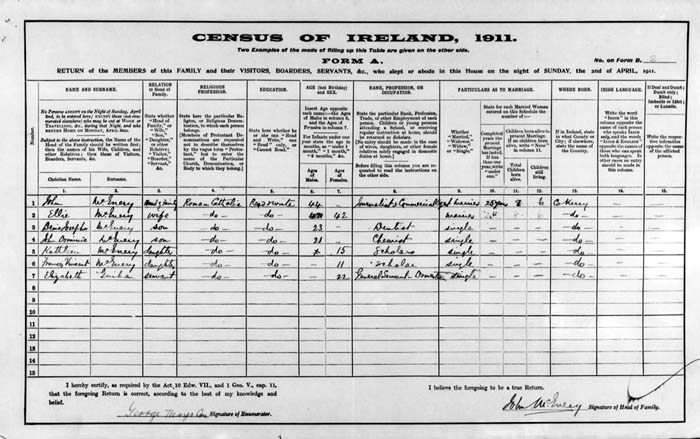
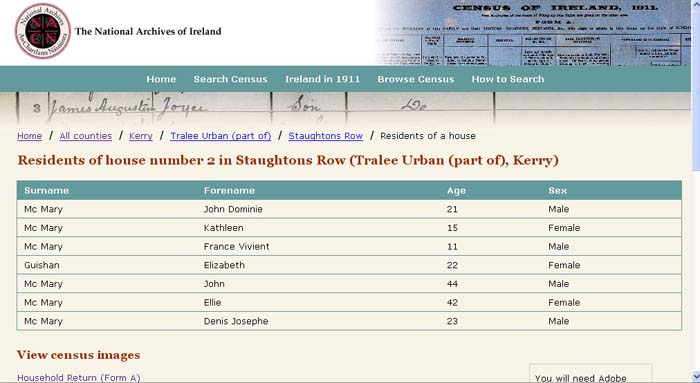
(retrieved from http://www.census.nationalarchives.ie 6 March 2009, reproduced courtesy of National Archives of Ireland).
Appendix 2

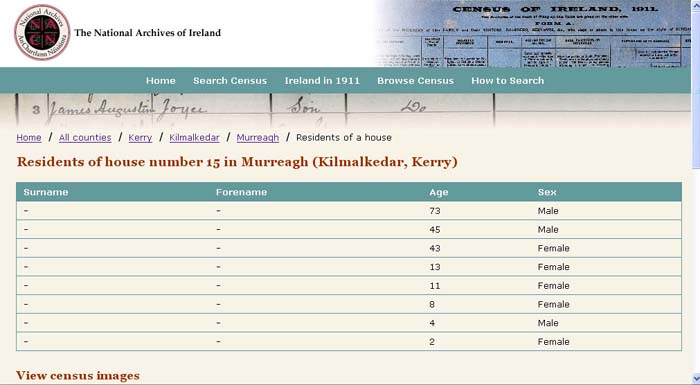
1911
Census return and blank index entries for family of Seán Ághas
(John Ashe), Murreagh, County Kerry
(retrieved from
http://www.census.nationalarchives.ie 6 March 2009, reproduced
courtesy of National Archives of Ireland).
[Note: dashes replaced with transcriptions as of July 2009]
Addendum I, 5 June 2009
In late May 2009 the National Archives released online the 1911 Census for five additional counties, with the following comment:

This
would indicate that senior Archives staff are at last beginning to come
to terms with the serious indexing errors and omissions in the census
online project, and there is no more talk of ‘independent
statistical analysis’ validating the quality of the work carried out to
date (requests for sight of said alleged analysis have been ignored). While it
may be the case that the 'vast majority' of users will be able to find
the census particulars they want online, the 10%-plus sample error
and omission rate outlined in the above report remains utterly
unacceptable, particularly in view of the large amount of scarce public
funds invested, a figure now in excess of €3.5 million, and this during a time of looming national bankruptcy. But perhaps the
quality of the latest online release is much improved when compared
with the earlier material? Unfortuately, sample checks would indicate
that the quality of indexing of the latest material is just as inept as that which has gone before. Dipping in at
random to Cork City, one finds that the Scannell family of 6 Caroline
Street is indexed as 'Seannell', O'Callaghan of number 7.2 in the same street
as 'O Callaghan', in number 8.2 Barry appears as 'Marry' and in number 16
Buckley as 'Ruckley'. Moving on to Castle Street next in the list,
Curtin of number 5 appears as 'Curlin', McMahon of number 6 as 'Mc
Mahon', O'Connor of number 7 as 'O' Connor', Mulcahy of number 9 as 'Mc
Leahy' and Dineen of the same household as 'Denien'. Once again large
numbers of census returns have been indexed with the forename in place
of surname and vice versa, so that in Cork City and County there are
approximately 100 cases where 'Mary', sometimes with a second name, is
given as the surname.
These
results again point to error rates well in excess of 10%, but this is
still not the end of the matter. As in the cases analysed in the main
body of the report above, masses of Cork census returns have been left
completely unindexed, mostly where the form was completed in
Gaelic. The following images relating to the 1911 Census return for the
Galvin family of Castle Town, DED Castletown, County Cork (reproduced courtesy of
the National Archives) well demonstrate this problem.
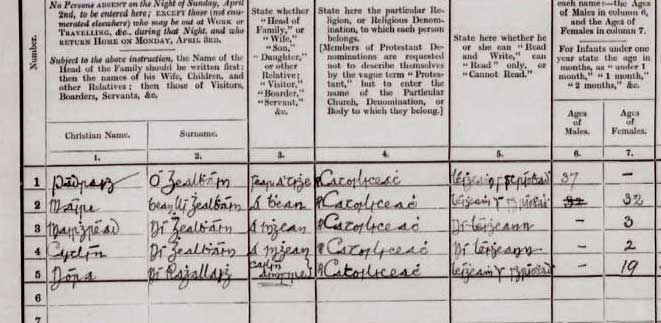
This census form is 'indexed' as follows on the National Archives site:
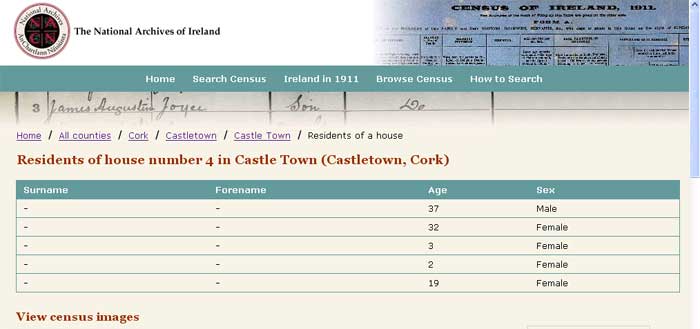
The present writer is not a well-paid public servant with holiday, sick-leave, conference travel, 'privilege day' and work expenses entitlements, but I will take the time nonetheless to point out to senior Archives staff, all of whom should be at least as familiar with the Irish lanaguage as myself, how to go about deciphering the above 1911 Census form. The task is admittedly complicated by the use of An Cló Gaelach or old Gaelic script, but this should not be a problem for those in their 50s or older who were trained at school to use this style before its replacement with An Cló Rómánach or modern script. Of course, the contemporary enumerator's form B.1, also online, helps us out immediately by listing the head of the family as Patrick Galvin (again, how ironic that the British regime could handle Gaelic translations better than Irish officials today). Secondly, with the aid of Woulfe's Sloinnte Gaedheal is Gall and MacLysaght's Surnames of Ireland, supplemented where necessary with a good Irish-English dictionary, the above details can be transcribed and translated as follows, with some inevitable uncertainties indicated by question marks:
Pádraig Ó Gealbháin/Patrick Galvin, head of family
Máire Bean Uí Ghealbháin/Mary? Galvin, wife
Mairghréad Ní Ghealbháin/Margaret Galvin, daughter
Caitlín Ní Ghealbháin/Kathleen? Galvin, daughter
Nóra Ní Raghallaigh/Nora (O?)Reilly, servant
It should be noted that Máire can sometimes be
translated as Maria or Maura, Caitlín sometimes as Catherine, while the
'O' prefix was not always used in the English version of the surname.
The incorporation of entries such as the above in an online database is
admittedly not easy but could be achieved with proper consultation and planning. Indeed the problem of Gaelic
entries emphasises the need for a proper soundex or variant form search
facility, which is lacking on the National Archives site, as well as
doubly underlining the necessity to have a standardised system of
dealing with 'O' and 'Mac' surnames (again, my advice is to employ
the received forms, eg, O'Sullivan, McCarthy). Now this is just
the sort of tutorial which I had in mind when I offered to visit the
National Archives free of charge and advise senior staff on the census
project, which offer as noted above was ignored. I am keenly aware that
the census project is a complex one and that I do not possess all the
answers, but it would appear that I do have some useful ideas to
impart.
To conclude, I do not wish to reflect unfairly on
Library and Archives Canada, which is stated to have been contracted by
the National Archives to carry out most of the work on the online
census project, but how could such a respected repository issue a
product so flawed as that which is under review? In particular, the
treatment of census forms completed in Gaelic is equivalent to an Irish
body contracting to index Canadian census returns and leaving
any French-language forms encountered untranslated and unindexed.
Of course the primary responsibility for the deficiencies of the online
census project lies with the National Archives, which would appear to
have farmed out the indexing of the censuses to people woefully
uneducated concerning the English forms of Irish surnames and
completely ignorant of their Gaelic forms. Once again I call on the
Director and senior staff of the National Archives to pause work
on the census online project until the problems outlined here have been
resolved and if necessary to stand aside and pass the task on to more
competent agents.
Addendum II, 16 July 2009
While not stooping to acknowledge this report on the online census project properly, senior National Archives staff are showing more signs of tacitly acknowledging criticisms which were formerly ignored or dismissed out of hand. In particular, a belated attempt is being made to deal with the particularly embarrassing failure to make provision for the translation of census returns completed in Gaelic. It would appear that a special effort is being made to deal with the County Kerry returns highlighted above, and having secured the services of someone with a knowledge of Gaelic, transcriptions of forms completed in that language are being added to the online database. However, English translations of the surnames still appear to be strangely absent, so that for example, in the townland of Murreagh the dashes noted above have been replaced with Gaelic names only, which will leave those with a little or no knowledge of the language at a disadvantage. To spell this out, what good is it to index families known to descendants in the United States of America only as 'Kevane' or 'Ashe' in the unfamiliar forms 'Ua Caomháin' or 'Ághas'? Indeed such is the real as opposed to the professed degree of knowledge of Gaelic in Ireland, that there will be more than a few in this country who would be left struggling by this failure of comprehensive indexing. Furthermore, there are signs of confusion in these belated amendments, as for example in the case of the O'Sullivan family of Derrynid Townland, Dawross DED, County Kerry, where one entry is translated but garbled over two lines and the other entries merely transcribed:
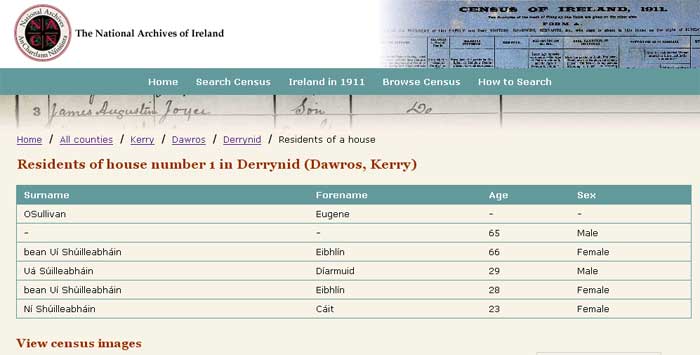

For the record, the above names might be listed for integration in the database as follows (noting again the inevitable uncertainties concerning English forms of forenames):
Eoghan Ua Súilleabháin/Eugene O'Sullivan, head of
family (English form of name confirmed Form B1)
Eibhlín Bean Uí Shúilleabháin/Ellen? O'Sullivan, wife
Diarmuid Ua Súilleabháin/Dermot O'Sullivan, son
Eibhlín Bean Uí Shúilleabháin/Ellen? O'Sullivan, daughter-in-law
Cáit Ní Shúilleabháin/Kate? O'Sullivan, daughter
While some attempt has thus been made by the National Archives to deal with
the untranslated Gaelic census returns, sampling indicates that the
even more numerous general errors of transcription remain, so that for
example in Green Street, Dingle, the above listed misreadings of
'O'Cannor' for O'Connor', 'McCartley' for McCarthy, 'Salvin' for
Galvin, and so on, still remain uncorrected. As the son of a Kerryman
from the Kilmalkedar Gaeltacht area, I was in a position quickly to
identify the untranslated census forms in Kerry, but sample checks in
other counties now online are revealing quite a number of cases where
forms were completed in Irish but left untranslated and unindexed (of
which more anon). In any case, piecemeal
corrections of the more ridiculous errors and omissions will not
suffice, and indeed it is probably practically impossible in terms of
time and expense to seek out and correct all errors at this stage. The
present writer is more convinced than ever that the online census
project needs to be halted and reviewed thoroughly, and possibly also
passed on to more competent hands as recommended above. As I write, the
McCarthy Report ('An Bord Snip Nua') is being digested today by the
nation, its proposals for swingeing cuts in public expenditure designed
to stave off looming national bankruptcy. At a time when social
welfare, health and education are all targeted for reductions, the
well-intentioned but disastrously executed €3.5 million National
Archives online census project, originally due to have been completed
by now but with only nine counties online, can hardly be allowed to continue, at least in its present
form. There need be no shame in admitting that one has bitten off more
than one can chew and standing aside, indeed the present writer has had
this experience in relation to a mini-census project which he formerly
undertook. The contrast between Ireland and the US and
Britain, the bulk of whose census returns have been online for
some time and where private as opposed to public bodies carried out
most of the work, could not be greater.
Finally, in order to ensure that I understood the
online census project properly, and as senior staff have been ignoring
ordinary correspondence, I submitted a Freedom of Information
application to the National Archives for relevant records on 6 April
2009. Over three months later I am still waiting for this application
to be processed, an indication that the National Archives of Ireland
operates to a relaxed time scale all of its own, as well perhaps as
displaying that 'hauteur' to which I have referred elsewhere.
Note: The National Archives uploaded the entire 1911 Census on its website in 2009, apparently with the intention of attending to transcription errors at a later stage. While the Archives did release certain records to the writer in 2009, it has without explanation withheld crucial material documenting project cost and error rates, so that it has not been possible to complete this section of the report.